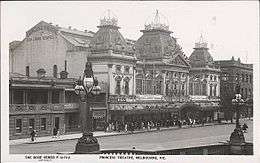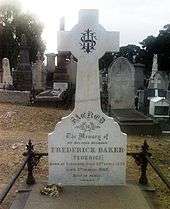Frederick Federici

Frederick Federici (22 April 1850 – 3 March 1888) was an Italian-born British opera singer best known for his work in early performances of the Savoy Operas written by Gilbert and Sullivan. Early in his career, Federici also worked as a talent agent and wrote songs before becoming a concert singer.
Federici toured extensively with the D'Oyly Carte Opera Company from 1879 to 1887. His roles included the Pirate King from The Pirates of Penzance in its first performance in 1879. He also played, among other roles, Captain Corcoran in H.M.S. Pinafore, Colonel Calverley in Patience, Strephon in Iolanthe and Florian in Princess Ida. He appeared in the title role in The Mikado (1885) and as Sir Roderic in Ruddigore (1887) in the first American productions of those works.
In 1887, Federici moved to Australia where he played in Gilbert and Sullivan and other operas with the J. C. Williamson company. His last role was Mephistopheles in Gounod's opera Faust at the Princess Theatre in Melbourne in March 1888. On opening night, after he sang the last note of the opera, and as he descended through a trap door in the stage, he had a heart attack and died suddenly. Ever since then, a legend holds that his ghost haunts that theatre.[1]
Early career and first D'Oyly Carte roles

Born as Frederick Baker in 1851 in Florence, Italy, "Fred" Federici moved to Britain as a youth. He trained for the diplomatic service, but at the age of 23 decided instead to pursue a singing career[2] and also worked for a time as a theatrical agent.[3] He married fellow D'Oyly Carte Opera Company artist Lena Monmouth (real name Jane Elenor Finili; born 1860) in 1879.[4] The couple had two children, including a daughter, Marguerite Ellissa Anita Baker (1882–1936).[5][6] An author and songwriter, Federici wrote the song "Dearer than all to me" (1874).[7]
Federici, a bass-baritone, began his performing with concerts and oratorio but was soon engaged at London's Theatre Royal, Drury Lane.[2][8] His first leading role in a D'Oyly Carte Opera Company production was in July 1879 when he took over as Captain Corcoran on a tour of H.M.S. Pinafore. In March 1880 he switched to the role of Bill Bobstay in the same production.[7]
To secure the British copyright for the new Gilbert and Sullivan opera The Pirates of Penzance, which was to open in New York the following night[9] the Pinafore touring company gave a perfunctory performance of Pirates the afternoon before the New York premiere, at the Royal Bijou Theatre in Paignton, Devon, organised by Helen Lenoir, the secretary and future wife of Richard D'Oyly Carte. The cast, including Federici, which was performing Pinafore in the evenings in Torquay, received some of the music for Pirates only two days beforehand. Having had only one rehearsal, they travelled to nearby Paignton for the matinee, where they read their parts from scripts carried onto the stage, making do with whatever costumes they had on hand.[10] Federici played the role of the Pirate King. In August 1880 he appeared briefly as Mr. Liverby in In the Sulks, the curtain-raiser that was played before H.M.S. Pinafore.[7]
Peak career, America and Australia
In other D'Oyly Carte tours of the Gilbert and Sullivan operas, from late 1880, he appeared as Captain Corcoran in H.M.S. Pinafore and then Samuel in The Pirates of Penzance. He next appeared as the Pirate King in Pirates in 1881. The Era wrote that Federici "is capital as the Pirate King".[11] He Played Colonel Calverley from 1882 to 1883 in Patience.[7][12] One local reviewer wrote that Federici "has a somewhat powerful voice, which comes out well in the patter song ... "If you want a receipt for that popular mystery," whilst his solo "When first I put this uniform on," was received with great éclat,[13] and another said that he "evoked enthusiastic applause".[14]

Through most of 1883 Federici toured as Strephon in Iolanthe. The Leeds Mercury wrote that "Federici, vocally and otherwise was excellent as Strephon".[15] So did the Manchester Times.[16] The Bristol Mercury and Daily Post thought that "Strephon was effectively rendered by Mr. F. Federici, who not only acquitted himself very satisfactorily in the singing, but infused into the part a vein of quiet humour".[17] However, The Era had a mixed reaction: "Mr. F. Federici, though a good actor, is a trifle too robust in style",[18] and the Liverpool Mercury wrote that "he is too conscious of the importance of the place he holds in the piece".[19] In 1884 he played Florian in Princess Ida. The Era called him "most artistic" in the role.[20] In the first half of 1885, he toured as the Counsel to the Plaintiff in Trial by Jury and Sir Marmaduke Pointdextre in The Sorcerer, while also continuing to appear as Florian in Princess Ida.[7]
In July 1885, he toured Britain in the title role in The Mikado before being sent to New York to play the same role in the first American production of that opera at the Fifth Avenue Theatre. Following an American tour of The Mikado, Federici returned to Britain briefly in May 1886 to tour as Dick Deadeye in H.M.S. Pinafore and as the title character in The Mikado before taking the latter work on a D'Oyly Carte tour of Austria and Germany until January 1887. In February 1887 he made his only appearance at the Savoy Theatre in London as the ghost Sir Roderic Murgatroyd in two matinee performances of Ruddigore before being sent back to New York to play the same role until April 1887 in the first American production of Ruddigore, again at the Fifth Avenue Theatre. Following this production, he left the D'Oyly Carte Opera Company.[7]
Federici and his wife then travelled to Australia to join J. C. Williamson's company with which, in July 1887, he played Florian at the Princess Theatre in Melbourne in the first production in that country of Princess Ida. In August 1887 he appeared at the same theatre as Harry Sherwood in Alfred Cellier's operetta Dorothy,[21] and in December 1887 he appeared there with Leonora Braham, in Edward Jakobowski's hit musical comedy Erminie, in the role of the Marquis de Pontvert.[22] Other roles in Australia included the Mikado, the Pirate King, Dick Deadeye, Colonel Calverley and Strephon.[6]

Death and ghost legend
On 3 March 1888 Federici was performing the role of Mephistopheles in Gounod's opera Faust on opening night at the Princess Theatre in Melbourne, Australia.[6] Nellie Stewart was playing Margeurite, and Alfred Cellier was conducting.[23] The opera ended with Mephistopheles sinking dramatically through a trapdoor, as he returned to the fires of hell, bearing Faust with him. However, as Federici was being lowered down into the basement, he had a heart attack and died within minutes.[6] He was 37 years old. The Press of Melbourne wrote about Federici's career, performance and the events of the evening:
The tragic and appalling occurrence of the sudden decease of Mr Federici from heart disease at the conclusion of the performance will be fresh in the memory of all, and must command universal sympathy and regret. Mr Federici achieved considerable success both in England and America in comic opera, but he was also an excellent musician and the composer of several songs of more than average merit, and before his association with comic opera had successfully appeared as a vocalist at some of the best concerts in London, including the Monday Popular Concerts at St. James's Hall. It seems an act almost of irreverence to criticise the performance of an actor who has only just been carried to his grave. Nevertheless, it is only his due and his proper tribute to say that he both sang and acted on Saturday night in a truly artistic manner and that he has never been seen to greater advantage than he was on that occasion.
His death created a terrible feeling of consternation, first in the company, with whom he had but a few minutes before been in association, and next, of course, in the public mind. The audience knew nothing of the occurrence, for his [collapse] took place actually beneath the stage, after he and Mr. Leumane [as Faust] had descended through the trap. It was one of those many tragedies which have happened in connection with the history of the stage, and it will not soon be forgotten. The theatre was closed on Monday evening out of respect to the memory of the deceased artist.[8]

The Argus newspaper in Melbourne carried a detailed account of the incident. It noted that soon after he collapsed, Federici was carried to the theatre's green room, where his doctor was unable to revive him and pronounced him dead. He had been suffering with heart disease for some time.[6]
Of course, Federici never returned to the stage for his bows. The cast onstage were unaware of his sudden death, but when they were told of what had happened at the end of the opera, they said that he had just been onstage and taken the bows with them.[1][24][25] Since then, members of the theatre's staff have claimed to see a ghostly figure in evening dress at the theatre. For many years, a third-row seat in the dress circle was kept vacant in his honour on every opening night.[26][27]
He was buried in Melbourne General Cemetery on 5 March 1888.[28] The Federici Bistro in Melbourne is named after him.[29]
See also
References
- 1 2 The Theatre Ghost – Australian Broadcasting Corporation (2004)
- 1 2 "Stonehenge: Federici – Melbourne's Theatre Ghost", Myth or Reality, Angelfire.com, accessed 18 June 2014
- ↑ Frederick Baker, Ancestry.com – pay to view
- ↑ Stone, David. "Lena Monmouth", Who Was Who in the D'Oyly Carte Opera Company, 1 November 2011, accessed 16 June 2014
- ↑ Marguerite Ellissa Anita Baker (1882–1936), Ancestry.com – pay to view
- 1 2 3 4 5 "Shocking Occurrence at the Princess's Theatre: Tragic Death of Mr. Federici", The Argus, 5 March 1888, p. 8
- 1 2 3 4 5 6 Stone, David. Frederick Federici, Who Was Who in the D'Oyly Carte Opera Company, 27 August 2001, accessed 16 June 2014
- 1 2 "Production of Faust in Melbourne", The Press, Volume XLV, Issue 7025, 29 March 1888, p. 3, National Library of New Zealand
- ↑ Performances had to be given in Britain before publication in order to secure copyright. See Stephens, John Russell. The Profession of the Playwright: British Theatre 1800–1900, Cambridge University Press (1992), pp. 104–15
- ↑ Ainger, Michael Gilbert and Sullivan : A Dual Biography: Oxford University Press (2002), pp. 180–81
- ↑ Pirates review in Norwich, The Era, 24 September 1881
- ↑ Programme for Patience, 27 March 1882, Royal Albert Hall in Reading, reprinted at Gilbert & Sullivan: a selling exhibition of memorabilia, accessed 16 June 2014
- ↑ "Patience at the Theatre Royal, Huddersfield", The Huddersfield Daily Chronicle (West Yorkshire, England), 16 May 1882, p. 3
- ↑ "Patience at the Theatre Royal", Hampshire Telegraph and Sussex Chronicle, (Portsmouth, England), 4 October 1882
- ↑ Iolanthe review The Leeds Mercury, 24 April 1883
- ↑ "Theatre Royal", Manchester Times, 3 March 1883
- ↑ Iolanthe review, The Bristol Mercury and Daily Post (Bristol, England), 5 June 1883
- ↑ Review of Iolanthe, The Era, 16 June 1883
- ↑ "Prince of Wales Theatre", Liverpool Mercury (Liverpool, England), 13 March 1883
- ↑ "Gaiety Theatre" (Dublin, Ireland), The Era, 3 May 1884
- ↑ Moratti, Mel. Federici, "Down Under in the 19th Century", accessed 16 June 2014
- ↑ Richards, Leann. "Theatre in Melbourne 1888", History of Australian Theatre, accessed 16 June 2014
- ↑ Tallis, Michael and Joan. "Chapter Four: Preparation of an Irish Immigrant", The Silent Showman: Sir George Tallis, the Man Behind the Worlds Largest Entertainment Organisation of the 1920s, p. 34, Wakefield Press (2006) ISBN 1862547351
- ↑ "Top Ten Haunted Places in Australia", Haunted America Tours website, accessed 16 June 2014
- ↑ "The Princess Theatre in Melbourne", Melbourne for Everyone, accessed 16 June 2014
- ↑ Federici and the Princess Theatre in Melbourne, Theatricalia, accessed 16 June 2014
- ↑ Graeme Blundell, "Marvellous Melbourne", The Age, 27–28 August 2005
- ↑ Federici, Melbourne General Cemetery website, accessed 16 June 2014
- ↑ "The Story of Federici", Federici Bistro, accessed 17 June 2014
External links
- Federici's Theatre Credits on broadwayworld.com
- 'The Not So Final Curtain of Frederick Federici' – Unexplainable.Net
- 'Federici the real Phantom of the Opera in Haunted' – YouTube